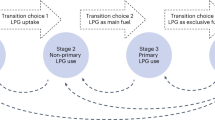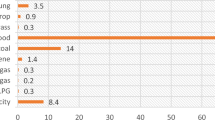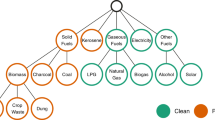Abstract
Household solid-fuel (biomass, coal) burning contributes to climate change and is a leading health risk factor. How and why households stop using solid-fuel stoves after adopting clean fuels has not been studied. We assessed trends in the uptake, use and suspension of household stoves and fuels in a multiprovincial cohort study of 753 Chinese adults and evaluated determinants of clean-fuel uptake and solid-fuel suspension. Over one-third (35%) and one-fifth (17%) of participants suspended use of solid fuel for cooking and heating, respectively, during the past 20 years. Determinants of solid-fuel suspension (younger age, widowed) and of earlier suspension (younger age, higher education and poor self-reported health status) differed from the determinants of clean-fuel uptake (younger age, higher income, smaller households and retired) and of earlier adoption (higher income). Clean-fuel adoption and solid-fuel suspension warrant joint consideration as indicators of household energy transition. Household energy research and planning efforts that more closely examine solid-fuel suspension may accelerate household energy transitions that benefit climate and human health.
This is a preview of subscription content, access via your institution
Access options
Access Nature and 54 other Nature Portfolio journals
Get Nature+, our best-value online-access subscription
$29.99 / 30 days
cancel any time
Subscribe to this journal
Receive 12 digital issues and online access to articles
$119.00 per year
only $9.92 per issue
Buy this article
- Purchase on Springer Link
- Instant access to full article PDF
Prices may be subject to local taxes which are calculated during checkout



Similar content being viewed by others
Data availability
The data that support the findings of this study are available from the corresponding author upon request. Requests for datasets generated and analysed during the current study will be reviewed and made available on a case-by-case basis by the corresponding author with input from co-authors, subject to compliance with Research Ethics Board restrictions for the survey data. Figs. 1–4 and Supplementary Figs. 1–4 contain primary data.
Code availability
Requests for code developed and annotated in Stata 13 and R to process and analyse the primary data collected in this study will be reviewed and made available upon reasonable request.
References
Zheng, Y. et al. Air quality improvements and health benefits from China’s clean air action since 2013. Environ. Res. Lett. 12, 114020 (2017).
Tao, S. et al. Quantifying the rural residential energy transition in China from 1992 to 2012 through a representative national survey. Nat. Energy 3, 567–573 (2018).
E-Handbook on Sustainable Development Goals Indicators (UNSD, 2018).
Rosenthal, J., Quinn, A., Grieshop, A. P., Pillarisetti, A. & Glass, R. I. Clean cooking and the SDGs: integrated analytical approaches to guide energy interventions for health and environment goals. Energy Sustain. Dev. 42, 152–159 (2018).
Bonjour, S. et al. Solid fuel use for household cooking: country and regional estimates for 1980–2010. Environ. Health Perspect. 121, 784–790 (2013).
Carter, E. et al. Assessing exposure to household air pollution: a systematic review and pooled analysis of carbon monoxide as a surrogate measure of particulate matter. Environ. Health Perspect. 125, 076002 (2017).
GBD 2015 Mortality and Causes of Death Collaborators. Global, regional, and national life expectancy, all-cause mortality, and cause-specific mortality for 249 causes of death, 1980-2015: a systematic analysis for the global burden of disease study 2015. Lancet 388, 1459–1544 (2016).
Huang, Y. et al. Global radiative effects of solid fuel cookstove aerosol emissions. Atmos. Chem. Phys. 18, 5219–5233 (2018).
Chafe, Z. A. et al. Household cooking with solid fuels contributes to ambient PM2.5 air pollution and the burden of disease. Environ. Health Perspect. 122, 1314–1320 (2014).
Cohen, A. J. et al. Estimates and 25-year trends of the global burden of disease attributable to ambient air pollution: an analysis of data from the Global Burden of Diseases Study 2015. Lancet 389, 1907–1918 (2017).
Johnson, M. A. & Chiang, R. A. Quantitative guidance for stove usage and performance to achieve health and environmental targets. Environ. Health Perspect. 123, 820–826 (2015).
Shen, G. et al. Evaluating the performance of household liquefied petroleum gas cookstoves. Environ. Sci. Technol. 52, 904–915 (2018).
Quinn, A. K. et al. An analysis of efforts to scale up clean household energy for cooking around the world. Energy Sustain. Dev. 46, 1–10 (2018).
State of Electricity Access Report 2017 (World Bank, 2017).
Kowsari, R. & Zerriffi, H. Three-dimensional energy profile: a conceptual framework for assessing household energy use. Energy Policy 39, 7505–7517 (2011).
Masera, O. R., Saatkamp, B. D. & Kammen, D. M. From linear fuel switching to multiple cooking strategies: a critique and alternative to the energy ladder model. World Dev. 28, 2083–2103 (2000).
van der Kroon, B., Brouwer, R. & van Beukering, P. J. H. The energy ladder: theoretical myth or empirical truth? Results from a meta-analysis. Renew. Sustain. Energy Rev. 20, 504–513 (2013).
Campbell, B. M., Vermeulen, S. J., Mangono, J. J. & Mabugu, R. The energy transition in action: urban domestic fuel choices in a changing Zimbabwe. Energy Policy 31, 553–562 (2003).
Trac, C. J. Climbing without the energy ladder: limitations of rural energy development for forest conservation. Rural Soc. 20, 308–320 (2011).
Alkon, M., Harish, S. P. & Urpelainen, J. Household energy access and expenditure in developing countries: evidence from India, 1987–2010. Energy Sustain. Dev. 35, 25–34 (2016).
Snider, G. et al. Impacts of stove use patterns and outdoor air quality on household air pollution and cardiovascular mortality in southwestern China. Environ. Int. 117, 116–124 (2018).
Kar, A. et al. Real-time assessment of black carbon pollution in Indian households due to traditional and improved biomass cookstoves. Environ. Sci. Technol. 46, 2993–3000 (2012).
Hanna, R., Duflo, E. & Greenstone, M. Up in smoke: the influence of household behavior on the long-run impact of improved cooking stoves. Am. Econ. J. Econ. Policy 8, 80–114 (2016).
Beltramo, T. & Levine, D. I. The effect of solar ovens on fuel use, emissions and health: results from a randomised controlled trial. J. Dev. Eff. 5, 178–207 (2013).
Agarwal, B. Diffusion of rural innovations: some analytical issues and the case of wood-burning stoves. World Dev. 11, 359–376 (1983).
Manibog, F. R. Improved cooking stoves in developing countries: problems and opportunities. Annu. Rev. Energy 9, 199–227 (1984).
Ruiz-Mercado, I. & Masera, O. Patterns of stove use in the context of fuel–device stacking: rationale and implications. Ecohealth 12, 42–56 (2015).
Malla, S. & Timilsina, G. R. Household Cooking Fuel Choice and Adoption of Improved Cookstoves in Developing Countries: A Review Working Paper No. 6903 (World Bank, 2014).
Rehfuess, E. A., Puzzolo, E., Stanistreet, D., Pope, D. & Bruce, N. G. Enablers and barriers to large-scale uptake of improved solid fuel stoves: a systematic review. Environ. Health Perspect. 122, 120–130 (2014).
Puzzolo, E., Pope, D., Stanistreet, D., Rehfuess, E. A. & Bruce, N. G. Clean fuels for resource-poor settings: a systematic review of barriers and enablers to adoption and sustained use. Environ. Res. 146, 218–234 (2016).
Lewis, J. J. & Pattanayak, S. K. Who adopts improved fuels and cookstoves? A systematic review. Environ. Health Perspect. 120, 637–645 (2012).
Xie, Y. & Hu, J. An introduction to the China Family Panel Studies (CFPS). Chin. Sociol. Rev. 47, 3–29 (2014).
Qiu, H. G., Yan, J. B. & Jiang, Y. Renewable energy consumption in rural China: current situation and major driven factors. J. Beijing Inst. Technol. 17, 10–15 (2015).
Luo, Z. in Encyclopedia of Energy Vol. 5 (ed. Cleveland, C.) 493–506 (Elsevier, 2004).
Zhang, L., Yang, Z., Chen, B. & Chen, G. Rural energy in China: pattern and policy. Renew. Energy 34, 2813–2823 (2009).
Sinton, J. E. et al. An assessment of programs to promote improved household stoves in China. Energy Sustain. Dev. 8, 33–52 (2004).
Chan, K. H. et al. Trans-generational changes and rural–urban inequality in household fuel use and cookstove ventilation in China: a multi-region study of 0.5 million adults. Int. J. Hyg. Environ. Health 220, 1370–1381 (2017).
Duan, X. et al. Household fuel use for cooking and heating in China: results from the first Chinese Environmental Exposure-Related Human Activity Patterns Survey (CEERHAPS). Appl. Energy 136, 692–703 (2014).
Clark, S. et al. Adoption and use of a semi-gasifier cooking and water heating stove and fuel intervention in the Tibetan Plateau, China. Environ. Res. Lett. 12, 075004 (2017).
Ru, M. et al. Direct energy consumption associated emissions by rural-to-urban migrants in Beijing. Environ. Sci. Technol. 49, 13708–13715 (2015).
Chen, Y. et al. Transition of household cookfuels in China from 2010 to 2012. Appl. Energy 184, 800–809 (2016).
Shen, G. et al. Factors influencing the adoption and sustainable use of clean fuels and cookstoves in China: a Chinese literature review. Renew. Sustain. Energy Rev. 51, 741–750 (2015).
Thomas, E., Wickramasinghe, K., Mendis, S., Roberts, N. & Foster, C. Improved stove interventions to reduce household air pollution in low and middle income countries: a descriptive systematic review. BMC Public Health 15, 650 (2015).
Leach, G. & Mearns, R. Beyond the Woodfuel Crisis: People, Land and Trees in Africa (Routledge, 2013).
Heltberg, R. Fuel switching: evidence from eight developing countries. Energy Econ. 26, 869–887 (2004).
Joon, V., Chandra, A. & Bhattacharya, M. Household energy consumption pattern and socio-cultural dimensions associated with it: a case study of rural Haryana, India. Biomass-. Bioenergy 33, 1509–1512 (2009).
Andadari, R. K., Mulder, P. & Rietveld, P. Energy poverty reduction by fuel switching. Impact evaluation of the LPG conversion program in Indonesia. Energy Policy 66, 436–449 (2014).
Johnson, N. G. & Bryden, K. M. Energy supply and use in a rural West African village. Energy 43, 283–292 (2012).
Johnson, N. G. & Bryden, K. M. Factors affecting fuelwood consumption in household cookstoves in an isolated rural West African village. Energy 46, 310–321 (2012).
Mukhopadhyay, R. et al. Cooking practices, air quality, and the acceptability of advanced cookstoves in Haryana, India: an exploratory study to inform large-scale interventions. Glob. Health Action 5, 19016 (2012).
Thurber, M. C., Phadke, H., Nagavarapu, S., Shrimali, G. & Zerriffi, H. ‘Oorja’ in India: assessing a large-scale commercial distribution of advanced biomass stoves to households. Energy Sustain. Dev. 19, 138–150 (2014).
Kammen, D., Goldemberg, J. & Johansson, T. in Energy as an Instrument for Socio-Economic Development (eds Goldemberg, J. & Johansson, T. B.) Ch. 5 (UN Development Programme, 1995).
Geels, F. W. Disruption and low-carbon system transformation: progress and new challenges in socio-technical transitions research and the multi-level perspective. Energy Res. Soc. Sci. 37, 224–231 (2018).
Geels, F. W., Sovacool, B. K., Schwanen, T. & Sorrell, S. Sociotechnical transitions for deep decarbonization. Science 357, 1242–1244 (2017).
Verbong, G. & Geels, F. The ongoing energy transition: lessons from a socio-technical, multi-level analysis of the Dutch electricity system (1960–2004). Energy Policy 35, 1025–1037 (2007).
Singh, D., Pachauri, S. & Zerriffi, H. Environmental payoffs of LPG cooking in India. Environ. Res. Lett. 12, 115003 (2017).
Davis, S. J. & Socolow, R. H. Commitment accounting of CO2 emissions. Environ. Res. Lett. 9, 084018 (2014).
Turnheim, B. & Geels, F. W. Regime destabilisation as the flipside of energy transitions: lessons from the history of the British coal industry (1913–1997). Energy Policy 50, 35–49 (2012).
Aung, T. W. et al. Health and climate-relevant pollutant concentrations from a carbon-finance approved cookstove intervention in rural India. Environ. Sci. Technol. 50, 7228–7238 (2016).
Barrington-Leigh, C. et al. An evaluation of air quality, home heating and well-being under Beijing’s programme to eliminate household coal use. Nat. Energy 4, 416–423 (2019).
Barrett, J. R. How good is good enough? Cookstove replacement scenarios to reach indoor air goals. Environ. Health Perspect. 123, A216 (2015).
Stamler, J. et al. INTERMAP: background, aims, design, methods, and descriptive statistics (nondietary). J. Hum. Hypertens. 17, 591–608 (2003).
Yan, L. et al. Study protocol: the INTERMAP China Prospective (ICP) Study. Wellcome Open Res. 4, 154 (2019).
Cragg, J. G. Some statistical models for limited dependent variables with application to the demand for durable goods. Econometrica 39, 829–844 (1971).
Wooldridge, J. M. Econometric Analysis of Cross Section and Panel Data (MIT Press, 2010).
Acknowledgements
We thank the study participants and field staff involved in the ICP study. This publication was supported by the Wellcome Trust, UK (grant 103906/Z/14/Z); National Natural Science Foundation of China, China (grant 81473044 and Innovative Research Groups grant 51521005); the Canadian Institutes for Health Research (grant 137535). E.C. received support through NIH/Fogarty’s Clean Cooking Implementation Science Network with support from the NIH Common Fund.
Author information
Authors and Affiliations
Contributions
J.B., Q.C., M.E., P.E., F.K., X.Y., Y.W. and L.Z. designed, or contributed to the design of, the study. J.B., Q.C., E.C., L.Y. and Y.F. led the fieldwork. E.C. carried out the analysis. E.C., J.B., B.R., L.Y. and Q.C. wrote the paper, and all other authors contributed to discussion of the results and commented on the manuscript.
Corresponding authors
Ethics declarations
Competing interests
The authors declare no competing interests.
Additional information
Publisher’s note Springer Nature remains neutral with regard to jurisdictional claims in published maps and institutional affiliations.
Supplementary information
Supplementary Information
Supplementary Figs. 1–5 and Tables 1–5.
Rights and permissions
About this article
Cite this article
Carter, E., Yan, L., Fu, Y. et al. Household transitions to clean energy in a multiprovincial cohort study in China. Nat Sustain 3, 42–50 (2020). https://doi.org/10.1038/s41893-019-0432-x
Received:
Accepted:
Published:
Issue Date:
DOI: https://doi.org/10.1038/s41893-019-0432-x
This article is cited by
-
Factors associated with the use of liquefied petroleum gas in Ghana vary at different stages of transition
Nature Energy (2024)
-
Examining energy inequality under the rapid residential energy transition in China through household surveys
Nature Energy (2023)
-
Household air pollution from solid fuel use as a dose-dependent risk factor for cognitive impairment in northern China
Scientific Reports (2022)
-
Improving rural women’s health in China: cooking with clean energy
Environmental Science and Pollution Research (2022)
-
A hybrid heterogeneous Pythagorean fuzzy group decision modelling for crowdfunding development process pathways of fintech-based clean energy investment projects
Financial Innovation (2021)



